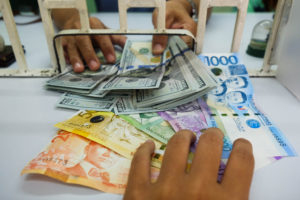The Philippines’ stimulus package to recover from the COVID-19-induced recession may be relatively smaller compared to the actual damage inflicted on the economy so far, but President Duterte’s chief economic manager said this prudent spending strategy would benefit the sectors that needed help the most.
“Despite not having the biggest stimulus package and even with the strictest lockdown, the Philippines performed better than some economies owing to its strengths,” Finance Secretary Carlos Dominguez III said in a speech before foreign business chambers on Tuesday, referring to the record 16.5-percent year-on-year drop in gross domestic product (GDP) during the second quarter.
Dominguez noted that the Philippines’ stimulus package was estimated to be worth 4.2-6.4 percent of GDP, smaller than the second-quarter GDP contraction.Separate Asian Development Bank estimates showed that as of Aug. 10, the Philippines’ war chest against COVID-19 amounted to $21.05 billion, equivalent to 5.72 percent of GDP.
“This is not the usual economic crisis, where a larger stimulus package translates into a milder recession. For instance, we have seen that there doesn’t seem to be a direct correlation between the size of one’s stimulus package and the drop in GDP. At least for the three countries that we looked at, their economies retreated significantly despite massive stimulus packages, which shouldn’t be the case,” Dominguez said.
The three countries that Dominguez referred to were Malaysia, whose GDP fell 17.1 percent in the second quarter despite a stimulus package worth 18.2 percent of GDP; Sweden, whose economy contracted by 8.2 percent despite a stimulus plan equivalent to 10.8-16.6 percent of GDP; and the United Kingdom, whose GDP declined by 21.7 percent despite a stimulus equivalent to 23.4 percent of GDP.
“It appears that no matter how much money countries pump into their economies, their GDP would have shrunk massively anyway. It is not the sheer size of the stimulus package that matters now but also whether it is actually saving the productive parts of the economy. This is because the problem is not a systemic contraction or a cyclical bust. Simply, necessary mobility restrictions hamper aggregate demand,” Dominguez said.
“If we can keep the pandemic at bay so that tough restrictions are not necessary, the economy should recover. In the meantime, we have to make sure we can adequately finance the country’s needs during a protracted struggle with this virus,” Dominguez added.
“We know that our economy’s revival will not happen in a sprint. We are prepared for a long and difficult recovery that requires fiscal stamina. We will continue to deploy our resources prudently until we are sure we are on the right side of the curve,” according to Dominguez.
As such, Dominguez said that the planned stimulus pending in Congress—estimated to cost P140-165 billion—would not only be affordable but also a package that could be fully executed.
“We support a fiscally responsible Bayanihan to Recover as One Act, which will provide another round of fiscal measures to stimulate consumer demand and support businesses and individuals critically impacted by COVID-19,” the finance chief said.
According to Dominguez, also included in the stimulus plan were additional capital for government financial institutions to address small and big firms’ liquidity and solvency problems, respectively; forming asset management firms that would allow banks to dispose of bad loans and assets; passage of the Corporate Recovery and Tax Incentives for Enterprises Act to attract more multinational companies through lower income taxes and a longer period to enjoy fiscal perks; and bigger support for agriculture through banking sector assistance across the entire value chain.


